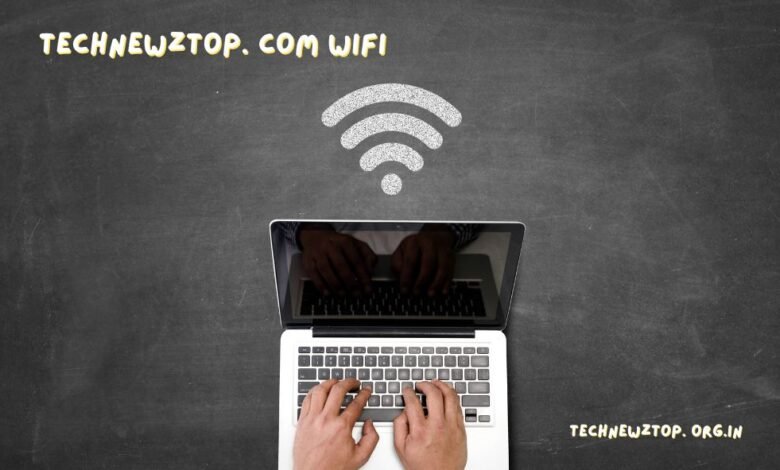
In today’s hyper-connected world, having reliable and secure WiFi is not just a luxury but a necessity. With the increasing reliance on digital communication and online activities, understanding and managing your WiFi network’s security has become paramount. This article provides an in-depth look at WiFi technology, discusses how Technewztop.com employs advanced WiFi solutions, and offers practical advice on how to secure your WiFi network. By the end, you will be well-equipped to enhance your network’s security and navigate the digital landscape responsibly.
Understanding WiFi Technology
What is WiFi?
WiFi, short for Wireless Fidelity, is a technology that allows devices to connect to the internet without physical cables. It uses radio waves to transmit data between a router and connected devices, enabling wireless communication and access to the internet. WiFi technology has evolved significantly since its inception, providing faster speeds, better coverage, and improved security.
How Does WiFi Work?
WiFi operates using radio frequency (RF) signals. A wireless router sends out RF signals that are received by WiFi-enabled devices. These devices then convert the RF signals into data that can be used by applications and services. The router acts as a bridge between the internet and your devices, facilitating data exchange.
The Evolution of WiFi Standards
WiFi standards have evolved over time to accommodate increasing demands for speed, range, and security. The key standards include:
IEEE 802.11b
Introduced in 1999, this was one of the first WiFi standards. It operates on the 2.4 GHz band and offers speeds up to 11 Mbps.
IEEE 802.11g
Released in 2003, this standard also operates on the 2.4 GHz band but provides faster speeds up to 54 Mbps.
IEEE 802.11n
Debuted in 2009, 802.11n operates on both 2.4 GHz and 5 GHz bands, offering speeds up to 600 Mbps through MIMO (Multiple Input Multiple Output) technology.
IEEE 802.11ac
Known as WiFi 5, this standard, introduced in 2013, operates on the 5 GHz band and offers speeds up to several gigabits per second.
IEEE 802.11ax
The latest standard, WiFi 6, was released in 2019. It operates on both 2.4 GHz and 5 GHz bands, offering increased speeds, better efficiency, and improved performance in crowded environments.
Common WiFi Security Protocols
WPA2 (Wi-Fi Protected Access II)
WPA2 has been the standard for WiFi security for many years. It provides strong encryption and is widely used in both consumer and enterprise networks. WPA2 uses AES (Advanced Encryption Standard) for encryption, which is highly secure.
WPA3 (Wi-Fi Protected Access III)
WPA3 is the latest security protocol, introduced to address vulnerabilities in WPA2. It offers improved encryption, better protection against brute-force attacks, and enhanced security features for public networks. WPA3 is designed to provide a more robust defense against various types of cyber threats.
The Importance of WiFi Security
Risks Associated with Unsecured WiFi Networks
An unsecured WiFi network can expose users to a range of risks. Unauthorized individuals may gain access to your network, potentially compromising sensitive data. This can lead to issues such as data theft, unauthorized surveillance, and network misuse.
Legal and Ethical Implications of Unauthorized Access
Accessing a WiFi network without permission is illegal in many countries. The legal consequences can be severe, including fines and imprisonment. Ethically, unauthorized access to a network is a violation of privacy and trust. It is important to understand and respect the legal and ethical boundaries surrounding network access.
Securing Your WiFi Network
Best Practices for Enhancing WiFi Security
To ensure that your WiFi network remains secure, follow these best practices:
Create a Strong and Unique Password
Your WiFi password is the first line of defense against unauthorized access. Use a strong password that includes a combination of letters, numbers, and special characters. Avoid common phrases or easily guessable information.
Enable WPA3 Encryption
If your router supports it, enable WPA3 encryption. This provides the highest level of security and protects your network from various types of cyber-attacks. WPA3 is particularly effective in safeguarding your network against brute-force attacks.
Regularly Update Router Firmware
Router manufacturers regularly release firmware updates to fix security vulnerabilities and improve performance. Ensure that your router’s firmware is up to date to protect against potential threats and keep your network running smoothly.
Tools and Techniques for Network Security
Password Managers
Password managers can help you create and store complex passwords securely. They provide a convenient way to manage your WiFi password and other login credentials, reducing the risk of password-related security breaches.
Network Monitoring Tools
Network monitoring tools allow you to track who is accessing your WiFi network and identify any unauthorized devices. These tools can alert you to potential security threats and help you take action to protect your network.
Technewztop.com: Your Resource for Tech Insights
Overview of Technewztop.com
Technewztop.com is a leading review website that provides comprehensive insights into the latest technology trends, products, and services. Our content covers a wide range of topics, from tech tutorials and product reviews to industry news and updates.
How Technewztop.com Utilizes WiFi Technology
At Technewztop.com, we leverage advanced WiFi technology to deliver a seamless browsing experience to our users. Our team continuously explores and implements the latest developments in WiFi technology to enhance our site’s performance and security. This commitment ensures that our readers have access to reliable and up-to-date information.
Ethical Alternatives to Gaining WiFi Access
Requesting Permission from Network Owners
The most ethical way to access a WiFi network is to ask for permission from the network owner. This approach respects privacy and helps avoid legal issues associated with unauthorized access.
Utilizing Public WiFi Networks
Public WiFi networks are available in many public places, such as libraries, cafes, and airports. These networks offer a legal and convenient alternative for temporary internet access without infringing on private networks.
Educational Resources for WiFi Security
Where to Learn More About Network Security
For those interested in deepening their knowledge of WiFi security, several online resources are available:
Coursera
Coursera offers a variety of cybersecurity courses, including those focused on WiFi security. These courses provide comprehensive knowledge and practical skills for securing your network.
Udemy
Udemy provides practical tutorials and courses on network security, covering both fundamental and advanced topics. These courses are designed to help you understand and implement effective security measures.
Khan Academy
Khan Academy offers free educational resources that cover the basics of network security and ethical hacking. These resources are a great starting point for anyone looking to learn more about protecting their WiFi network.
Advanced WiFi Security Techniques
Implementing Network Segmentation
Network segmentation involves dividing your network into smaller, isolated segments. This can enhance security by limiting the spread of potential threats and reducing the risk of unauthorized access to sensitive areas of your network.
Using VPNs for Enhanced Privacy
A Virtual Private Network (VPN) encrypts your internet connection, providing an additional layer of security. By using a VPN, you can protect your online activities from prying eyes and enhance your overall privacy.
Setting Up Guest Networks
If you need to provide internet access to visitors, consider setting up a separate guest network. This network should have its own password and security settings, keeping your primary network secure from potential risks.
Troubleshooting Common WiFi Issues
Slow WiFi Speeds
Slow WiFi speeds can be caused by various factors, including interference from other devices, network congestion, or hardware issues. To improve speeds, try positioning your router centrally, minimizing interference, and upgrading your router if necessary.
Frequent Disconnections
Frequent disconnections can be frustrating and may indicate problems with your router or network configuration. Check for firmware updates, ensure that your router is not overloaded, and verify that your network settings are correctly configured.
Limited Coverage
Limited WiFi coverage can occur if your router is not positioned optimally or if there are physical obstructions. Consider using WiFi extenders or mesh network systems to improve coverage in areas with weak signals.
Future Trends in WiFi Technology
WiFi 6E and Beyond
WiFi 6E is an extension of WiFi 6 that operates in the 6 GHz band, providing additional bandwidth and reducing congestion. Future advancements in WiFi technology will continue to focus on increasing speeds, enhancing security, and improving network efficiency.
Integration with IoT Devices
As the Internet of Things (IoT) continues to grow, WiFi technology will play a crucial role in connecting a wide range of devices. Future developments will aim to support the increasing demand for IoT connectivity while maintaining high levels of security and performance.
Conclusion
WiFi security is a critical aspect of modern technology that requires careful management and ethical behavior. By following best practices for securing your network, respecting the digital boundaries of others, and staying informed about the latest developments in WiFi technology, you can contribute to a safer and more reliable online environment. Technewztop.com is dedicated to providing valuable insights and updates to help you navigate the ever-evolving world of technology.
FAQs
Is it illegal to crack a WiFi password?
Yes, unauthorized access to a WiFi network is illegal and can lead to serious legal consequences, including fines and imprisonment.
How can I secure my WiFi network?
To secure your WiFi network, use a strong password, enable WPA3 encryption, regularly update your router’s firmware, and consider using additional security tools such as password managers and network monitoring tools.
What are the risks of attempting to crack a WiFi password?
Attempting to crack a WiFi password can result in legal penalties, exposure to malware, and potential compromise of your own network’s security.
Are there ethical alternatives to gaining WiFi access?
Yes, ethical alternatives include requesting permission from the network owner or using public WiFi networks.
Where can I learn more about WiFi security?
Educational platforms such as Coursera, Udemy, and Khan Academy offer courses and tutorials on WiFi security and ethical hacking.



